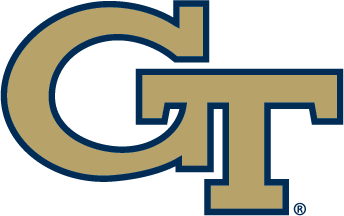May 21, 2014
By Matt Winkeljohn
RamblinWreck.com
Download offensive depth chart (PDF)
As Georgia Tech head football coach Paul Johnson rolls out the official-unofficial post-spring practice depth charts that are popular among fans if not coaches (partly because they are subject to change pending fall practice), there is a split on offense.
The Yellow Jackets list one senior (right guard Shaq Mason) as a starter among five linemen, yet four among six skill positions – and two of those are returning part-time starters while the others will be new in their roles.
Wide receiver DeAndre Smelter (eight starts), who returned to football last year after a three-year absence where he focused only on baseball, and A-back Synjyn Days (seven) have starting experience.
Smelter has since given up baseball to zero-in on the gridiron.
Similarly, while Johnson and his staff continue cross-training many players for multiple positions, they’re looking for players to hone in on whatever might make them stand out.
The Jackets will not stop working on their weaknesses, yet much as Tech has streamlined the offense with less (or perhaps no) emphasis on package expansions that last season included the shotgun and diamond formations, coaches are looking as hard or harder at ways to accentuate positives.
Here’s a look at how Johnson and Co. hope to make it happen:
A-backs
This may be the best position example of a new hyper focus on skill refinement.
Tech will be without the most productive A-back Johnson has had at the position, Robert Godhigh. All he did last season was rush for 744 yards – second on the team — and seven touchdowns, and lead the Jackets with 23 receptions for 471 yards (20.5-yard average) and two scores.
Seniors Tony Zenon and Days, a diminutive speedster and a former quarterback, respectively, are listed as starters at these positions.
There is logjam at these spots with B.J. Bostic, Deon Hill and converted B-back Broderick Snoddy bucking for playing time. Dennis Andrews also had a solid spring, and senior Charles Perkins is expected to be in the mix although he was severely limited during spring practice by a thigh injury.
A-backs coach Lamar Owens said there is no established protocol that spells out how many players Johnson deploys at this spot. It’s about getting results. With that in mind, Zenon (5-feet-8, 174 pounds) and Days (6-2, 232) bring different skill sets.
Zenon is more likely to be featured in the middle of the field, where there is more space, and Days would be more apt to have his number called near the goal line. Over the last half of last season, Days emerged as one of Tech’s better blockers on the perimeter.
“All of the A-backs . . . have different backgrounds, and played different positions in high school,” Owens said. “For what we do, since we’re a hybrid between a running back and a slot receiver, there are some guys who due to their size, or ability to change direction or their ability to catch the ball, they’re better suited to do some things in the passing game, or catching the pitch.
“This spring, we really just wanted to increase our strengths. Whatever your strength is, make it a weapon. Make it your calling card. If we need that thing, we’re going to go to you. Nobody wants to be average across the board; you’ve got to be great at something.”
There have been times in the past when the Yellow Jackets have deployed half a dozen A-backs on a game-by-game basis. Yet Owens said there is no guidline for distributing playing time beyond the pursuit of results. Among the top B-backs in Johnson’s tenure was a big back, Anthony Allen (6-0, 229), and a not-so-big back in Godhigh (5-7, 190).
Orwin Smith was between those two in size, yet especially quick and fast.
“Last year, we probably played four or five A-backs a game. Robbie [who played by far the most] had over 1,200 all-purpose yards catching and running which was the first time that’s happened since Paul has been here from an A-back who was not returning kicks,” Owens said.
“In 2011, we had the most production at the position and we played three guys: Roddy Jones, Embry Peeples and Orwin Smith. I tell the guys that; do I want to play six guys or two? I just want the production.”
The speedy Zenon did not see the field as much during his junior season as in his sophomore season. It showed this spring.
“I could tell that he was trying to play with a chip on his shoulder . . . and he needs to keep that,” Owens said. “I would think that him having a chip on his shoulder was a function of him not playing as much last year. That’s what I want . . . go out there every day and prove why you should be on the field.
“That’s really what Robbie Godhigh did. His story is a motivation for our entire team. He was a guy who walked on and scratched and clawed to get on the field and block for Orwin. He just grows and grows and makes it hard to take him off the field.”
Offensive Line
Without the work of these young men up front, the proficiency of Tech’s skill players will be diminished regardless of the speed, quickness and talent of the players throwing, catching and carrying the football.
Mason will land on several preseason watch lists as he prepares to start for the third consecutive season at right guard, and the rest of the line is more like a partially completed puzzle.
Left tackle Chris Griffin is the only redshirt freshman listed as an offensive (or defensive) starter, and one of two in the offensive two-deep, with the other being next door. Shamire Devine is penciled in as the No. 2 left guard behind junior Trey Braun.
Griffin is agile and extends his arms well most of the time, but as with proposed starting center Freddie Burden, a redshirt sophomore who missed last season with a knee injury, his next in-game snap will be his first at the collegiate level.
Burden was a tight end for much of his high school career, and has the agility that offensive line coach Mike Sewak likes, yet there were times during the spring that he — and to a degree several linemen — did not match their position requirements quite like the coach wants.
Burden saw a bit of time in the spring at tackle, although junior Bryan Chamberlain is most likely to remain the No. 1 right tackle.
“I’d like to have a guy sit in his spot and learn his technique and get good at it . . . without having to think about it,” Sewak said in the spring. “As soon as [we] get in a scrimmage situation, [some of what players have learned] goes out the window.”
Braun and Chamberlain were starters much of last season, with eight and seven posts, respectively, yet nobody on the offensive line outside of Mason ought to be considered a complete lock at his spot.
It is conceivable that an incoming freshman might fight his way into the two-deep, although if that doesn’t happen by the end of September, those players will become strong candidates to redshirt as Devine and Griffin did last fall.
Devine is the biggest offensive player recruited by Johnson and he flashes dominance, yet at 6-7, 370 (wink, wink), he has to improve his stamina.
Quarterback
This looks like a two-man race for the starting position, with sophomore Justin Thomas to enter fall camp ahead of junior Tim Byerly.
Thomas has played the most of the two, and they’re each different than the other, and from predecessor Vad Lee.
Johnson hopes that the Jackets can run his favored option more efficiently this season, and while Lee was third on the team last season in rushing (513 net yards, eight touchdowns), Tech will seek more explosiveness from the position.
Lee suffered 168 lost yards on sacks and runs, meaning with 681 yards gained, his ratio of positive yardage to lost yardage was 4.05. He averaged 2.8 yards per rush.
While it is not a perfect reflection because Lee was called upon to pass much more frequently per play than was Thomas, it is hard to ignore Thomas’ ratio of 19.0 after he rushed for 247 yards and lost 13 while averaging 7.1 yards per carry.
It should be pointed out that Thomas often faced lesser competition, but his numbers nonetheless pop and excite.
Byerly played less still, but with a ratio of 20.8 with 125 rushing yards to 6 lost, he, too may offer opportunity to move the ball the right direction.
Thomas sat out the spring game with a mild shoulder injury, and although Byerly struggled with ball control on a cold, windy night, he rushed 26 times for 101 yards against the bulk of Tech’s projected No. 1 defense.
They are different. Thomas (5-11, 185) is abundantly quick, and Byerly (6-0, 215) is more powerful. One might suggest he has something of a nose for contact in the vein of former Jacket signal caller Joshua Nesbitt.
As starting B-back Zach Laskey said, “[Byerly] is a tough kid, and he doesn’t mind putting his head down.”
Quarterbacks/B-backs coach Bryan Cook does not deny a notable difference in these two players, nor does he have an issue with that dichotomy.
“Each guy’s got his own style; there is no prototype,” Cook said. “For Justin, having done it for two years, mentally he has a good grasp and he sees things pretty well. He’s got some explosiveness, he gets out on the edge and gets down the field . . . He’s starting to get to where he’s playing fast, definitely faster.
“Tim, he’s just a different type. His eyes are more efficient than they were a year ago. His feet are more efficient. His decision-making, and production, are moving in the right direction.”
Between them, Thomas and Byerly attempted just 21 combined passes. Byerly completed 1-of-4 for three yards, and Thomas was 9-for-17 with two interceptions for 131 yards and a touchdown.
These are small sample sizes, obviously, and the spring game offered little chance to assess Byerly inasmuch as the weather conditions were dreadful.
The Jackets continue seeking improvement in the passing game, end whose means go beyond passers and catchers to pass protection, yet re-building the option game is no less a goal.
“They’re getting there,” Cook said of Thomas and Byerly running the triple option. “I think like anything it’s a work in progress. The first two guys are confident in it, they understand it. They still miss some reads, and do some things they wish they could get back.”
True freshman Matthew Jordan entered school in January and will enter the fall behind Thomas and Byerly.
Wide Receivers
Smelter started eight games last season, and with 21 receptions – some of them quite acrobatic — for 345 yards and four touchdowns.
He made enough of an impression that even with what will likely be just two years of college football spent in a run-oriented offense, he may earn the chance to become the fourth Johnson-coached wideout at Tech to find his way to the NFL, following Kevin Cone, Demaryius Thomas and Stephen Hill.
His transition from baseball went so well that early this spring he gave up the sport that brought the 6-3, 225-pounder to Tech as a scholarship athlete. With his size and athleticism, comparisons to Thomas and Hill are apt to follow.
Sophomore Micheal Summers is the starter on the other side, and although his opportunities to shine were less frequent last season, when he started 11 games and caught 10 passes for 211 yards, his speed is a strength.
Tech may be as deep at wide receiver as in Johnson’s tenure.
Senior Darren Waller (6-5, 232) started 14 games the past couple seasons, and senior Corey Dennis (6-2, 208) is a three-year letterman.
Sophomore Anthony Autry (6-2, 186) may be as talented as any Jacket wideout. Wide receivers coach Buzz Preston hasn’t been able to deploy him much, however, as he aggravated a knee injury last year, and he – like Waller – will be suspended for a couple games at the beginning of the season.
Autry played in eight games and started three as a freshman before suffering a season-ending knee injury.
The Jackets also have redshirt freshmen wideouts Antonio Messick and Ricky Jeune.
B-back
Last, but certainly not least as the fullback position in Paul Johnson’s offense stays busiest, Tech will enter fall practice in a bit of a flux at B-back.
Laskey, who was third on the team in carries (84) and fourth in rushing yardage (485) with seven touchdowns, will be the unquestioned starter.
After him, questions abound, although fifth-year senior Matt Connors is likely to open practice as the backup after freshman Travis Custis opted late in the spring to enroll at Hutchinson (Kan.) Community College for academic reasons.
Laskey was far more than an ample backup last season for leading rusher David Sims (884 yards, 11 touchdowns). At 6-1, 217, Laskey has plenty of what coaches call forward lean. He is every bit a north-south runner, and churns his legs with non-ponderous fury. He’s rushed for just under 1,200 career yards and last season he carried 84 times and did not fumble once.
Johnson occasionally harps on the senior’s blocking proficiency, but Laskey is as secure in his starting position as anyone on offense, including Mason and Smelter.
His positive-negative run ratio (487/2 = 243.5) last season was less impressive than Sims’ (885/1 = 885), but only for sake of a single run.
“He sees things, he understands things, and he’s done it for a good bit of time, and he’s a tough kid,” Cook said. “He’s got the mentality that you want. He’s what we’re looking for. His experience is going to help him play with confidence this fall.”
Connors is similar. He rushed 16 times for 102 yards and two scores.
Redshirt freshman Donovan Wilson (6-0, 213) and incoming freshman Christopher Leggett will get looks in the fall at B-back. It also is worth noting that A-backs Snoddy and Perkins have played the position previously.
“Matt’s a guy who’s done this, and understands the position,” Cook said. “He’s technically sound, and has played some for us. We ought to be able to get some downs out of him.
“Donovan was at A-back last year as a redshirt. We moved him, and that’s something that he wanted to do. He fits, and is still a work in progress.”
OFFENSE TWO-DEEP
Depth chart following the conclusion of spring practice. Does not include newcomers who were not enrolled during the spring.
Quarterback
Justin Thomas, r-So.
Tim Byerly, r-Jr.
B-Back
Zach Laskey, Sr.
Matt Connors, r-Sr. OR Donovan Wilson, r-Fr.
A-Back
Synjyn Days, r-Sr.
Broderick Snoddy, r-Jr.
A-Back
Tony Zenon, r-Sr.
B.J. Bostic, r-Sr.
Deon Hill, r-Sr.
Wide Receiver
Micheal Summers, r-So.
Darren Waller, Sr.
Wide Receiver
DeAndre Smelter, Sr.
Corey Dennis, Sr.
Left Tackle
Chris Griffin, r-Fr.
Chase Roberts, r-So.
Left Guard
Trey Braun, r-Jr.
Shamire Devine, r-Fr.
Center
Freddie Burden, r-So.
Thomas O’Reilly, r-Jr.
Right Guard
Shaquille Mason, Sr.
Nick Brigham, r-So.
Right Tackle
Bryan Chamberlain, r-Jr.
Errin Joe, r-Jr.
Each week, Inside the Swarm will give fans an in-depth look at Georgia Tech’s football program and the upcoming 2014 season. The series will include coaches and student-athletes. The defensive depth chart will be released next week.









